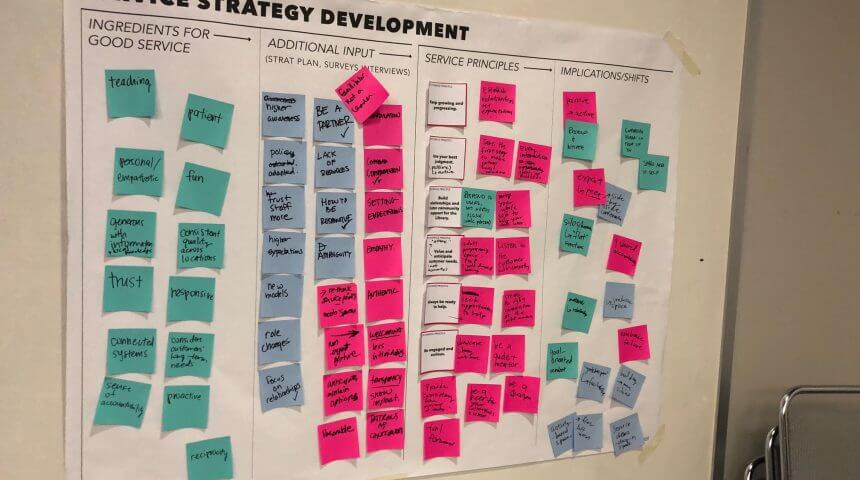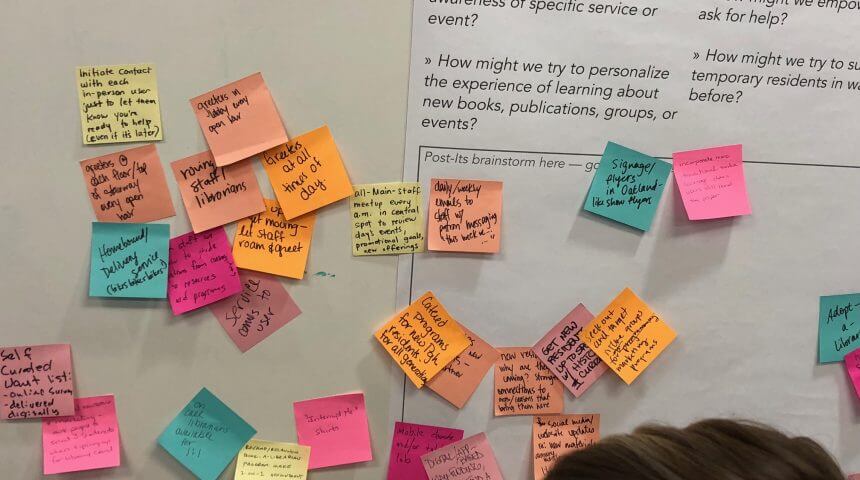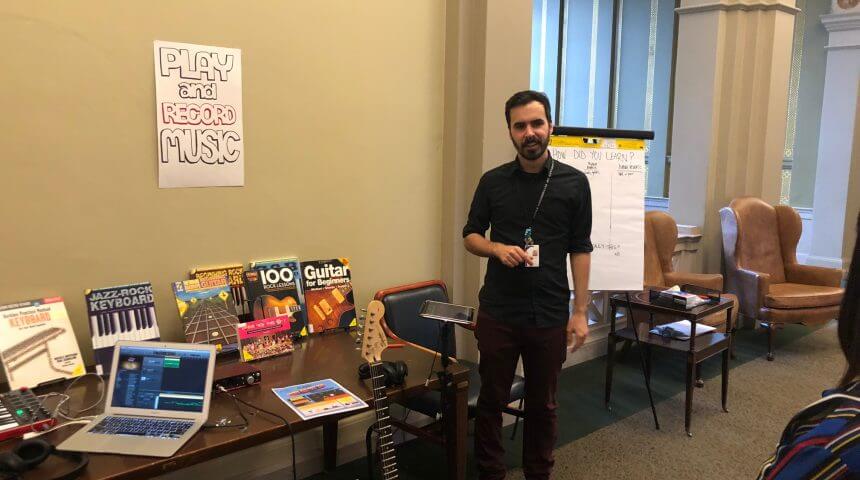How can we make your Main Library better? Carnegie Library of Pittsburgh has been working with design firm brightspot to engage our local community, staff and funders to imagine ways CLP – Main can serve the public in a fast-evolving city and region. The user research phase of this consulting project, which included town halls, user interviews and an online survey has been completed. We are excited to share that we had an excellent response to our interview requests and over 1,300 survey responses! Thank you for working alongside us to create an even more amazing CLP – Main.

The work of the prototyping phase began last week with the brightspot team visiting CLP – Main to facilitate two staff workshops. The first workshop centered on the CLP Service Strategy. We discussed remarkable service experience and define ingredients of good service. We used this process to successfully update and add to our service principles and identified some service shifts necessary to better meet your needs as defined in the feedback collected from you.
The day two staff workshop centered on Prototype Development. The work team reviewed some of the user research findings and considered their impact on thematic areas. These thematic areas include:
- Connecting with Others
- Finding and Getting Help
- Creating, Learning and Doing
- Discoveries that Delight
- Enhancing Digital Presence
After discussing some prototyping best practices, the group shifted to rapidly generating lots of ideas for prototypes. The larger team broke into thematic teams to refine the prototype ideas. Two prototypes were developed for each of the five topics. The work team spent last week refining and planning their prototypes and this week will launch, test and assess them this week.
We are excited to share with you a summary of each of the ten prototypes below and you will find the prototype launch schedule here. We encourage you will visit the Main Library over these next few weeks to test out these ideas and give us feedback as we continue to improve these ideas.

Please note that prototypes by design are imperfect and often messy. They are meant to be a trial run and the staff will be testing and learning as they go. We will all be working hard and moving fast over the course of these tests. Prototypes will allow the work team to gather indicators from you of potential success for creating the final three pilots in the coming months.
Prototype 1: Pop-Up Game Parlor (“Space for Connection”)
A key finding from brightspot’s interviews, surveys, and town hall meetings was that users are yearning to make connections. We’ll test whether designating a space in the library for recreational activities like puzzling, coloring, collaging and gaming changes the way users engage in this space. Our hope is that by setting public space aside for play and collaborative gaming it will enable spontaneous connections and build friendships. We are especially interested in whether this service will appeal to senior users and users already engaged in programs such as Conversation Salon and Wise Walks. We hope to discover whether a “conversation salon” can be not just a program, but also a service or space. We’ll test several spaces (including the Graphic Novels Room, Oversize Room, and TBD) by filling them with a variety of activities that can be engaged in collaboratively such as Jenga, Connect Four, Checkers and also conversation card games such as Table Topics and The Empathy Game. We’ll measure participation by observing users using the parlor and by collecting their brief, written feedback on passive comment boards.
Prototype 2: Sharing Immigrants’ Stories
We want to know whether listening to immigrant stories will help long-term Pittsburghers build empathy and feel more connected to Pittsburgh newcomers. During Let’s Speak English, participants will craft questions that they’ll use to interview each other via handheld recorders. These recorded stories will be shared via a listening station at the Main Library Welcome Center. These stories will also be shared at a subsequent Let’s Speak English where the public will be invited to meet the storytellers. We’ll measure the impact of this prototype anecdotally – through brief in-person conversations with listeners – and on paper – by reading the written responses that listeners post at the listening station.
Prototype 1: The Welcome Bar
The week of March 12th on Monday, Wednesday, and Friday at our busiest times (via door count; 12-2 pm, 3-5 pm, 1-3 pm) we will have 2 greeters stationed at the front door. Greeters who escort a patron somewhere will also ask and take note of answers on the following questions: What do you think about us stationing a greeter at the front entry? How did this impact your visit? Each day of the week of the 12th, we will have a new poster at the front door of the library with a chart that reads, Did your visit to the library today make you feel… welcome? Yes / No …a sense of belonging and inclusion? Yes / No …delighted to be here? Yes / No with a set of dot stickers, so patrons can express their opinions. We hope to find at the end of the week that there are more dots in the “Yes” answers on Monday, Wednesday, and Friday. If this is the result, we will know that a warm friendly greeting and hand off to the appropriate department will lead patrons to feel more welcome, included, and lead to a sense of delight and more patrons equipped to find and get help at the library.
Prototype 2: Service Awareness
Throughout the week of March 19th, there will be a new poster in the front hallway of the library that reads, “Did you learn something new at the library today?” With an option for patrons to put a sticker in the “No” column or the “Yes” column. On Monday, Tuesday, and Wednesday, there will be a infographic poster displayed in the front hallway that will give patrons a bingo board of services, that will push them to various departments, based on their needs. There will be staff stationed at the board during our busiest times those days (Monday 12-2pm, Tuesday 3-5 pm, Wednesday 3-5pm) who will stand by the poster and ask the following, “What do you like about our service awareness prototype? Is there anything you’d like to change about it? Did it bring anything new and interesting to your attention?” On Thursday and Friday, we will have no infographic stationed in the front of the building, so the “did you learn…?” sticker board will act as a control for us. By the end of the week, we hope to prove that a service graphic will lead to patrons being better able to learn something new / be more aware of the library services offered to them and, hence, more able to find and get the help they need at the library.

Prototype 1: Creative Pods
Making a variety of activities available including: music instruments/recording, sewing/knitting, and legos, origami in a central space in the library will help us understand our user interests. We will make hands on activities available in the second floor hallway, one set at a time. One day the station is unstaffed and one day the station is staffed (six days total). Resources are provided for each activity (books, a laptop with lynda.com, bookmarks and youtube, etc) for any patron to learn and play. Data is gathered by observing staff and a feedback paper with questions.
Prototype 2: Passive Device Bar
Feedback provided by users expressed a desire for the Library to offer a tech bar. Devices (ipads, tablets, kindle fire, laptop) will be set out with various eResources available on them- Libby, Overdrive, Hoopla, rbDigital, etc. A staff person is nearby to assist if necessary, but otherwise we will let it be a passive station to play with and try devices. User feedback sheet with questions is there, and the nearby staff person will collect data with the measurement worksheets.
Prototype 1: Art Vending Machine
In this two-part prototype, we will invite users to generate doodles and sketches to fill colorful plastic capsules. The capsules will then be placed in a receptacle that other users can retrieve on a different day. Users will be invited to make art at three different locations throughout the building, and staff will gather feedback through interviews and observation. We hope to explore how users feel about contributing to a sense of community delight, rather than just being passive consumers of information and services.
Prototype 2: Tiny Treasure Hunt
A hunt through the first floor that will uncover hidden architectural or general points of interest: the sink in the children’s space, the “hidden hallway” in the first floor fiction stacks, and the August Wilson diploma. We will have markers with information and a staff person at each point of interest to gather feedback. The “hidden hallway” will have a data collection point. Staff will gather feedback through observation, interviews, and creative polling. Participants will receive a pin at the end of the hunt as a reward for learning about the space.
Prototype 1: LiveStream Experiment: Side Hustle Series
We used Facebook Live to livestream the March 7 presentation in the Side Hustle series. We’ll evaluate how many people interact with the panel discussion live versus virtually, what sort of engagement happens on Facebook compared to in-person, and we’ll also ask online users for feedback about the quality of the experience.
Prototype 2: Virtual Tour
A down-and-dirty test of whether visitors to the Library’s home page will take a virtual tour of the Music, Film, and Audio Department. We have a panoramic photograph of the main reading room area, and we’ll populate that with 8-10 hotspots that share a variety of information about Music, Film, and Audio – some will talk about current services, some will feature historical information about the library, and some will be close-up photographs of cool architectural features. We’ll be looking at how many home page visitors take the tour and are hoping to be able to track what features get the most clicks.
Have you had a chance to try out any of these prototypes? Share your opinion in the comments.
